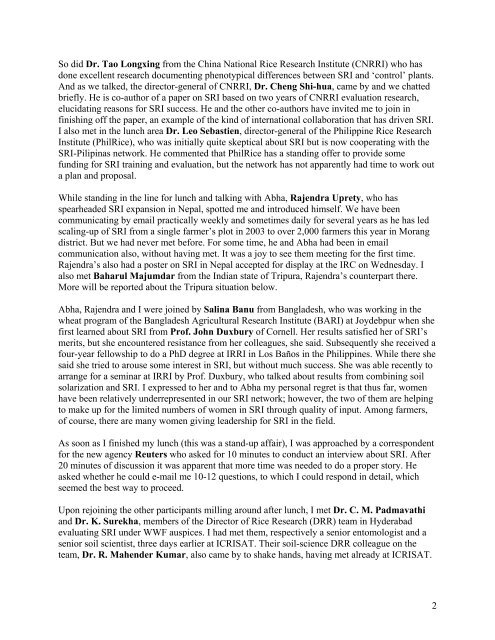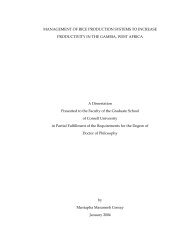REPORT FROM 2ND INTERNATIONAL RICE CONGRESS, NEW ...
REPORT FROM 2ND INTERNATIONAL RICE CONGRESS, NEW ...
REPORT FROM 2ND INTERNATIONAL RICE CONGRESS, NEW ...
Create successful ePaper yourself
Turn your PDF publications into a flip-book with our unique Google optimized e-Paper software.
So did Dr. Tao Longxing from the China National Rice Research Institute (CNRRI) who has<br />
done excellent research documenting phenotypical differences between SRI and ‘control’ plants.<br />
And as we talked, the director-general of CNRRI, Dr. Cheng Shi-hua, came by and we chatted<br />
briefly. He is co-author of a paper on SRI based on two years of CNRRI evaluation research,<br />
elucidating reasons for SRI success. He and the other co-authors have invited me to join in<br />
finishing off the paper, an example of the kind of international collaboration that has driven SRI.<br />
I also met in the lunch area Dr. Leo Sebastien, director-general of the Philippine Rice Research<br />
Institute (PhilRice), who was initially quite skeptical about SRI but is now cooperating with the<br />
SRI-Pilipinas network. He commented that PhilRice has a standing offer to provide some<br />
funding for SRI training and evaluation, but the network has not apparently had time to work out<br />
a plan and proposal.<br />
While standing in the line for lunch and talking with Abha, Rajendra Uprety, who has<br />
spearheaded SRI expansion in Nepal, spotted me and introduced himself. We have been<br />
communicating by email practically weekly and sometimes daily for several years as he has led<br />
scaling-up of SRI from a single farmer’s plot in 2003 to over 2,000 farmers this year in Morang<br />
district. But we had never met before. For some time, he and Abha had been in email<br />
communication also, without having met. It was a joy to see them meeting for the first time.<br />
Rajendra’s also had a poster on SRI in Nepal accepted for display at the IRC on Wednesday. I<br />
also met Baharul Majumdar from the Indian state of Tripura, Rajendra’s counterpart there.<br />
More will be reported about the Tripura situation below.<br />
Abha, Rajendra and I were joined by Salina Banu from Bangladesh, who was working in the<br />
wheat program of the Bangladesh Agricultural Research Institute (BARI) at Joydebpur when she<br />
first learned about SRI from Prof. John Duxbury of Cornell. Her results satisfied her of SRI’s<br />
merits, but she encountered resistance from her colleagues, she said. Subsequently she received a<br />
four-year fellowship to do a PhD degree at IRRI in Los Baños in the Philippines. While there she<br />
said she tried to arouse some interest in SRI, but without much success. She was able recently to<br />
arrange for a seminar at IRRI by Prof. Duxbury, who talked about results from combining soil<br />
solarization and SRI. I expressed to her and to Abha my personal regret is that thus far, women<br />
have been relatively underrepresented in our SRI network; however, the two of them are helping<br />
to make up for the limited numbers of women in SRI through quality of input. Among farmers,<br />
of course, there are many women giving leadership for SRI in the field.<br />
As soon as I finished my lunch (this was a stand-up affair), I was approached by a correspondent<br />
for the new agency Reuters who asked for 10 minutes to conduct an interview about SRI. After<br />
20 minutes of discussion it was apparent that more time was needed to do a proper story. He<br />
asked whether he could e-mail me 10-12 questions, to which I could respond in detail, which<br />
seemed the best way to proceed.<br />
Upon rejoining the other participants milling around after lunch, I met Dr. C. M. Padmavathi<br />
and Dr. K. Surekha, members of the Director of Rice Research (DRR) team in Hyderabad<br />
evaluating SRI under WWF auspices. I had met them, respectively a senior entomologist and a<br />
senior soil scientist, three days earlier at ICRISAT. Their soil-science DRR colleague on the<br />
team, Dr. R. Mahender Kumar, also came by to shake hands, having met already at ICRISAT.<br />
2
















